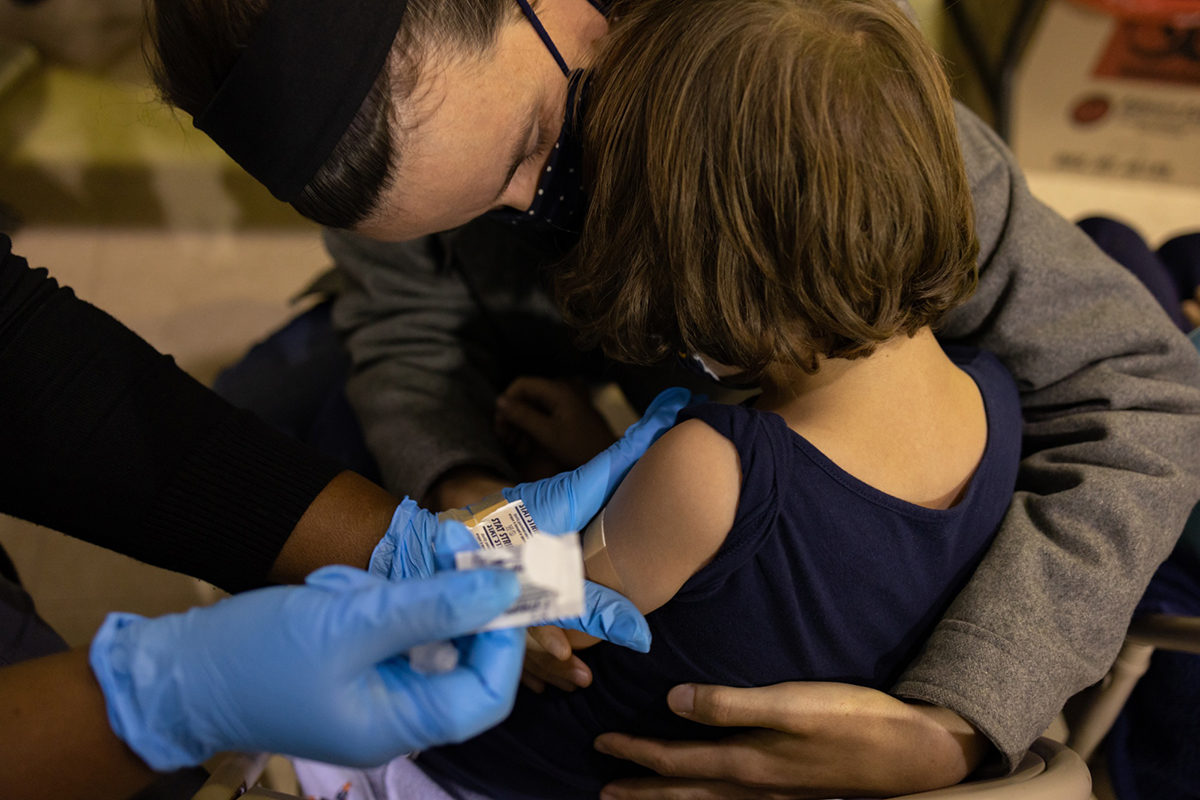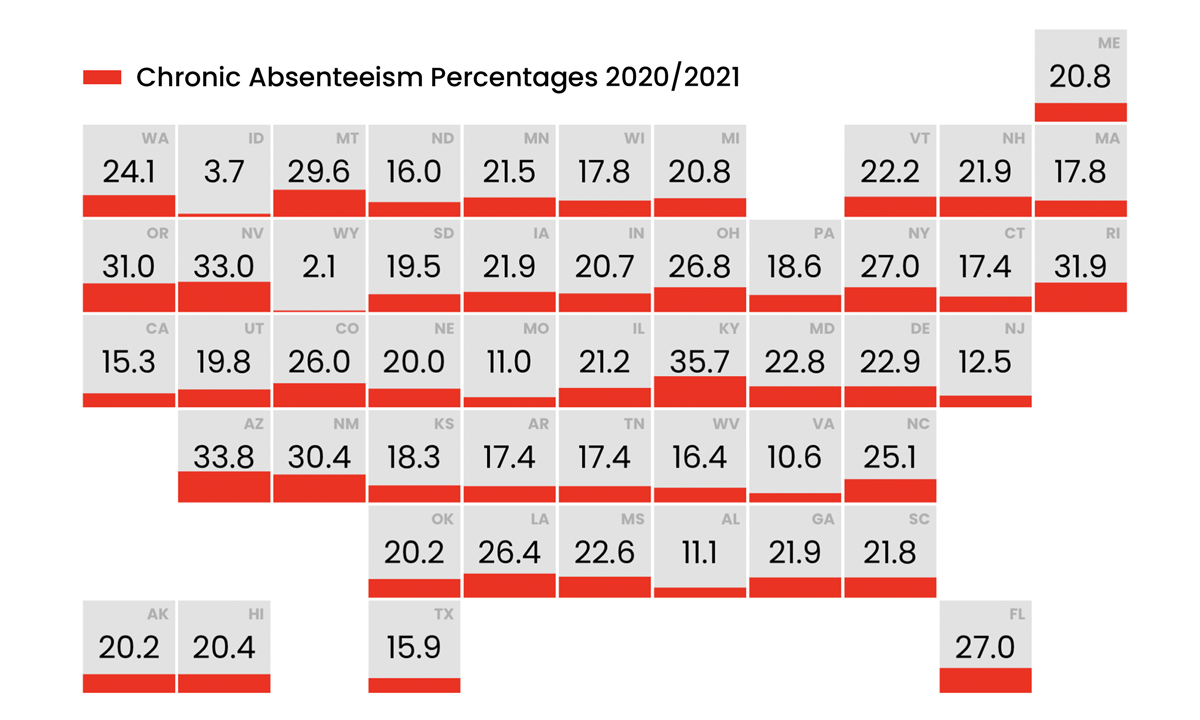COVID Brief: Low-Income Kids Should Get Free COVID Shots, CDC Says
A weekly roundup of headlines about how the pandemic is shaping schools and education policy, vetted by AEI Visiting Fellow John Bailey

Get stories like these delivered straight to your inbox. Sign up for The 74 Newsletter
This is our weekly briefing on the pandemic, vetted by John Bailey. See the full archive.

Low-Income Kids Should Get Free COVID Shots, CDC Panel Says
- Via Bloomberg
- “Low-income children should be able to receive COVID-19 vaccinations at no cost under the federal Vaccines for Children Program, according to a panel of U.S. health advisers.”
- “The CDC’s Advisory Committee on Immunization Practices voted unanimously to recommend COVID-19 shots from Moderna Inc. and Pfizer Inc.’s shot for children 6 months to 18 years old.”
- “While there is concern spreading online that adding COVID-19 vaccines to the immunization schedule would make them mandatory, Food and Drug Administration Commissioner Robert Califf said that won’t be the case.”
- More via Scott Gottlieb
- Stat’s Helen Branswell live tweeted the meeting.
The Big Three

States to ‘Likely See a Doubling’ of Pre-Pandemic Chronic Absenteeism
- An analysis in The 74
- “Compared to pre-pandemic rates in 2018-19, ‘we will likely see a doubling in chronic absence,’ said Hedy Chang, executive director of the nonprofit Attendance Works, which teamed with researchers at Johns Hopkins University to analyze the federal data. Those numbers showed that 10.1 million students missed at least 10% of the 2020-21 school year.”
- “One reason Chang suspects the federal count to be too low is because of the leap in chronic absenteeism in those four states. For example, the federal count shows 15.3% of California students were chronically absent in 2020-21. But according to School Innovation and Achievement, a company that works with districts to improve attendance, 27.4% of students were in the chronic to severe range last year — a time when schools were mostly open.”
How One School Is Beating the Odds in Math, Pandemic’s Hardest-Hit Subject
- Via The New York Times
- “The groundwork was laid before the pandemic, when [Benjamin Franklin Elementary in Meriden, Connecticut] overhauled how math was taught.”
- “It added as much as 30 minutes of math instruction a day. Students in second grade and above now have more than an hour, and fourth and fifth graders have a full 90 minutes, longer than is typical for many schools. Students no longer have lessons dominated by a teacher writing problems on a whiteboard in front of the class. Instead, they spend more time wrestling with problems in small groups. And, for the first time, children who are behind receive math tutoring during the school day.”
- “Any one of the changes may seem small. But pulling them off required an almost herculean effort and cultural shifts at every level. District officials needed to shake up teaching methods and the school day to maximize instruction time; principals needed to enforce the changes and teachers had to accept having less autonomy.”
FDA and CDC Authorize Updated COVID Booster Shots for Children 5 to 11
- FDA statement; CDC statement. More via The New York Times.
- “The revised shot developed by Pfizer-BioNTech previously had been cleared for those 12 and older, while Moderna’s updated booster was available only to those 18 and older. The action by the Food and Drug Administration will expand access to Pfizer’s shot to children as young as 5, and to Moderna’s shot to children 6 and older.”
City & State News
ARKANSAS: Rural teacher prep program delivers ‘job-embedded’ degrees — for $75 a month.
CALIFORNIA: The Los Angeles Unified School District’s student enrollment numbers are down again this school year — but not by as much as district leaders expected.
NORTH CAROLINA: “The N.C. Department of Public Instruction and North Carolina Collaboratory are leading a joint $6.73 million effort to spur research on the impact of COVID-19 on student learning in the state, with the goal of helping educators and students recover.”
HAWAII: The state Department of Education announced a partnership with Hazel Health that will expand access to mental health services for K-12 public school students. The statewide partnership will serve over 170,000 students across 295 schools.
COVID-19 Research
Babies Born During the Pandemic May Have Delayed Communication Skills
- NBC News on a new study
- “Around 89% of the infants studied who were born between 2008 and 2011 could articulate a full word like ‘bowl’ or ‘cup’ at 12 months old, compared to around 77% of infants born during the early months of the pandemic. The share of infants who could point at objects fell from 93% to 84%, and the portion who could wave goodbye fell from 94% to 88%.”
- “The results were based on a questionnaire given to parents of 309 babies in Ireland during the pandemic.”
- “Pandemic-associated social isolation may have impacted on the social communication skills in babies born during the pandemic compared with a historical cohort. Babies are resilient and inquisitive by nature, and it is hoped that with societal re-emergence and increase in social circles, their social communication skills will improve.”
Without a Nasal Vaccine, the U.S. Edge in Fighting COVID is on the Line
- Via Politico
- “Biden administration officials are raising concerns that the slow pace of developing a nasal vaccine for COVID-19 in the U.S. could pose a security risk as China, Iran and Russia approve their own vaccines taken through the nose or mouth.”
- “Though nasal and oral vaccines are being studied in the U.S., none are close to coming on the market because Congress hasn’t approved more money to support research and development. Big pharmaceutical companies are also not investing in these next-generation vaccines because they don’t see much profit potential.”
- “ ‘Intranasal vaccines — vaccines that are variant-resistant — those are critical tools to have in the toolbox for protecting Americans, not just for COVID but also for future pandemics and also for future biosecurity threats,’ Ashish Jha, the administration’s COVID-19 response coordinator, told Politico.”
Heart Risks, Data Gaps Fuel Debate over COVID-19 Boosters for Young People
- Via Science
- “Florida Surgeon General Joseph Ladapo ignited a furor this month when, based on a state analysis purporting to show COVID-19 vaccines were linked to cardiac deaths in young men, he advised men ages 18 to 39 to steer clear of the shots. Scientists slammed his warning and decried the eight-page analysis, which was anonymous and not peer reviewed, for its lack of transparency and flawed statistics.”
- “Still, COVID-19 vaccines do have a rare but worrisome cardiac side effect. Myocarditis, an inflammation of the heart muscle that can cause chest pain and shortness of breath, has disproportionately struck older boys and young men who received the shots. Only one out of several thousand in those age groups is affected, and most quickly feel better.”
- “FDA is requiring six myocarditis studies each from Pfizer and Moderna, the makers of the two mRNA vaccines.”
- “The big question is whether any risk, however minimal, to the heart is outweighed by the benefits of a booster. Young people are rarely hospitalized for COVID-19, but the virus is not risk-free for them either.”
- Related:
- Kristen Panthagani had concerns about the methodology cited by the Florida surgeon general.
- Katelyn Jetelina weighs the risks and benefits in this excellent post.
Viewpoints and Reports
Let’s Use the Pandemic as a Dress-Rehearsal for Much-Needed Digital Transformation
- Jean-Claude Brizard in The Hechinger Report
- “What should come next is an examination of how schools can more deeply and deliberately harness technology to make high-quality learning accessible to every learner, even in the wake of a crisis. That means a digital transformation, with three key levers for change: in the classroom, in schools and at the systems level.”
- “A digital transformation will also enable more dynamic ways of monitoring and supporting student progress. AI, for example, can support enhanced early warning systems that allow teachers and administrators to accurately identify needed interventions for individual learners.”
No Home Left Offline
- EducationSuperHighway’s second No Home Left Offline report highlights the critical steps needed to accelerate Affordable Connectivity Program (ACP) adoption and close the broadband affordability gap.
- “The ACP Enrollment Dashboard provides states and cities with the most up-to-date data on the number of ACP-eligible, enrolled and unconnected households in their area.”
- “GetACP.org is a virtual mobile assistant that simplifies the ACP enrollment process by helping applicants to check their eligibility, determine the easiest way to qualify, identify the documents needed when applying and find ‘free with ACP’ broadband plans available at their address.”
- “The Affordable Connectivity Program Adoption Toolkit for Local Leaders is a step-by-step guide that contains outreach templates, training materials and best practices to help leaders get the word out to eligible households.”
… And on a Reflective Note
The Crisis of Men and Boys:
- David Brooks reviews Richard Reeves’ new book, Of Boys and Men.
- “If you’ve been paying attention to the social trends, you probably have some inkling that boys and men are struggling, in the U.S. and across the globe.”
- “They are struggling in the classroom. American girls are 14 percentage points more likely to be ‘school ready’ than boys at age 5, controlling for parental characteristics. By high school, two-thirds of the students in the top 10% of the class, ranked by G.P.A., are girls, while roughly two-thirds of the students at the lowest decile are boys.”
- “Men are struggling in the workplace. One in three American men with only a high school diploma — 10 million men — is now out of the labor force. The biggest drop in employment is among young men aged 25 to 34. “
- “Richard V. Reeves’s new book, Of Boys and Men, is a landmark, one of the most important books of the year, not only because it is a comprehensive look at the male crisis, but also because it searches for the roots of that crisis and offers solutions.”
- Related: 74 Interview with Richard Reeves
- This might also be a contributing factor …
For even more COVID policy and education news, subscribe to John Bailey’s daily briefing via Substack.
Disclosure: John Bailey is an adviser to the Walton Family Foundation, which provides financial support to The 74.
Get stories like these delivered straight to your inbox. Sign up for The 74 Newsletter

;)
